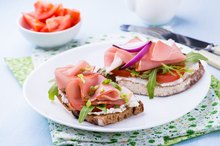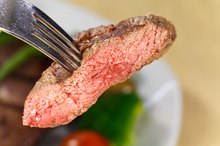Bile and Fat Digestion
Digestion is the process by which food is broken down into absorbable nutrients in your body. Digestion involves your mouth, esophagus, stomach, small intestine and large intestine, as well as accessory organs, which include the pancreas, liver and gallbladder. Different nutrients are absorbed in different areas of the body. Fat digestion, which requires a digestive fluid called bile, begins in the small intestine.
The Basics
Bile is a digestive fluid that consists of cholesterol, bile acids, water, potassium, sodium and bilirubin – a waste product formed from the breakdown of red blood cells. Bile, which is produced by the liver and stored in the gallbladder, plays a vital role in the digestion of fats. According to Colorado State University, humans produce 400 to 800 milliliters of bile per day.
Release of Bile
Food Absorption & Fat Emulsification in the Digestive System
Learn More
By the time digested food reaches your small intestine, it is referred to a chyme, a mixture of partially digested food and digestive juices, such as stomach acid. When the chyme enters the duodenum, the upper portion of the small intestine, the muscles of your gallbladder wall begin to contract. This rhythmic contraction releases bile into the common bile duct, the passageway that connects the gallbladder to the small intestine. In addition to bile, the pancreas releases lipases, which are digestive enzymes that are vital to fat digestion.
Creation of Micelles
Fats are hydrophobic, which means they do not dissolve in water. Without proper digestive juices, small molecules of fat would combine together to form one large molecule of fat. Bile prevents this from happening. Bile molecules contain a hydrophobic end, as well as a hydrophilic, or water-absorbent, end. When bile enters the small intestine, bile molecules attach to the fat molecule. The fat molecule absorbs the hydrophobic end of the bile molecule, allowing the hydrophilic end to protrude from the fat molecule like a tail. This hydrophilic end repels other fat molecules, preventing them from combining together. These coated fat molecules become known as micelles.
Completion of Fat Digestion
List of Non-starchy Foods
Learn More
Once fat molecules are converted into micelles, the lipase enzymes from the pancreas begin to break down the fat molecules into fatty acids and monoglycerides, which are fatty acids that contain glycerol. These substances are able to pass through the wall of the small intestine, where they enter intestinal cells called epithelial cells. In the epithelial cells, fatty acids and monoglycerides are converted to triglycerides, then coated with protein. The protein coating makes these molecules, now referred to as chylomicrons, water-soluble. Chylomicrons enter your lymphatic system, then travel to your bloodstream, where your body is able to use them.
Related Articles
References
Writer Bio
Lindsay Boyers has a Bachelor of Science in nutrition from Framingham State College and a certificate in holistic nutrition from the American College of Healthcare Sciences. She is also a licensed aesthetician with advanced training in skincare and makeup. She plans to continue on with her education, complete a master's degree program in nutrition and, ultimately, become a registered dietitian.









